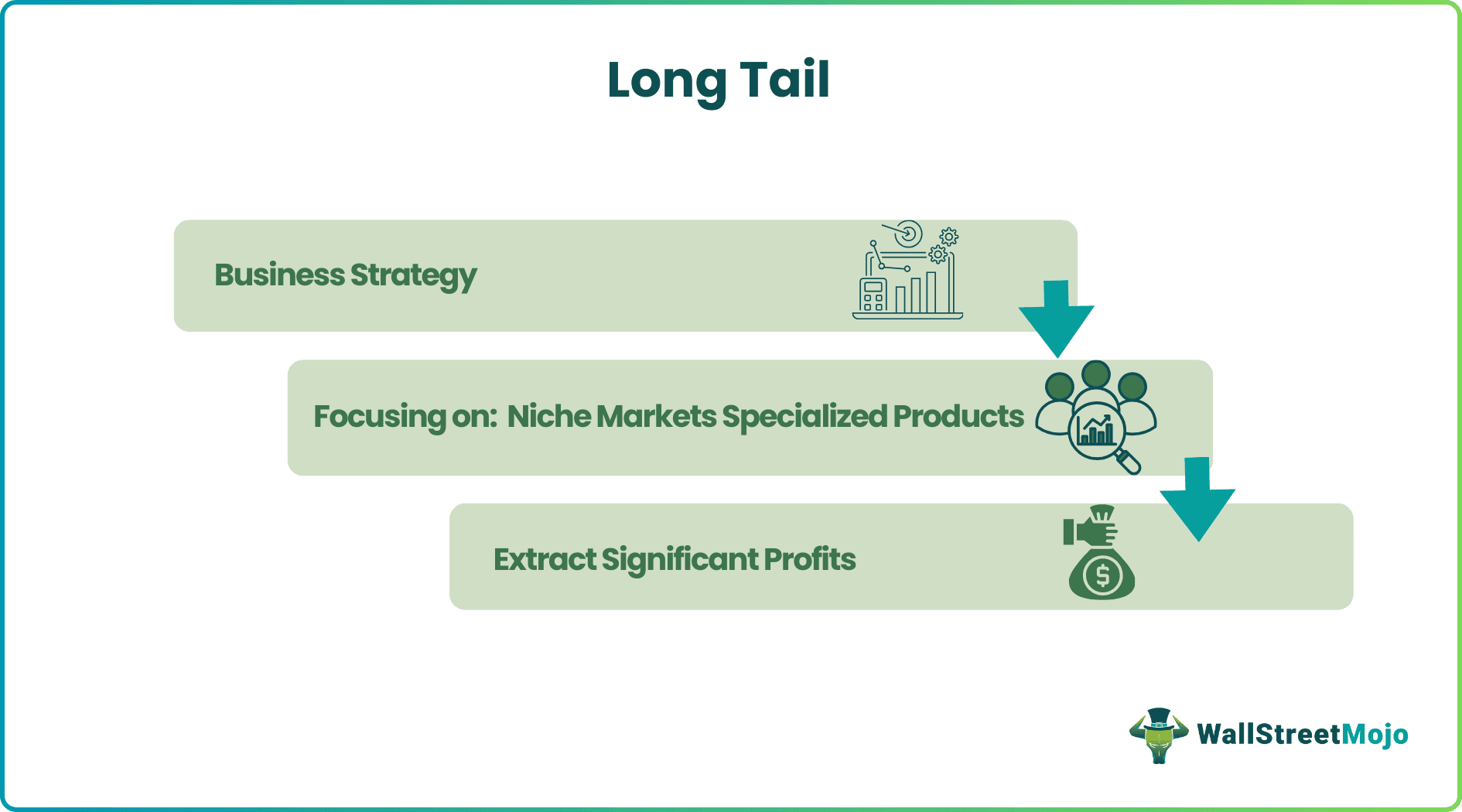Table Of Contents
What Is Long Tail?
A long tail refers to a business strategy that focuses on selling a wide variety of niche content, services, and products instead of emphasizing the sale of a few mainstream and popular items. It helps businesses achieve greater profits through the sale of low-volume, rare items to numerous customers.

It simply means that a business can thrive if it focuses on offering less demand and unique products instead of going after sales of blockbuster products. Long tail indicates the shift of consumers towards niche purchases from the mass market. It offers tailored solutions to specialized segments and harnesses its power.
Key Takeaways
- A long tail business strategy emphasizes the sale of an enormous range of niche goods, services, and content rather than strongly emphasizing the sale of a smaller number of well-known and mainstream products.
- It helps companies generate significant revenue by selling unique, low-volume goods to many clients.
- One can implement it by executing data analytics, SEO optimization, customized content, social media interaction, and influencer collaboration.
- Due to its unique and rare items fulfilling specific needs, it offers companies less competition, higher profit margins, revenue efficiency, customer loyalty, regular income, and SEO visibility.
Long Tail Business Strategy Explained
Long tail theory explains the business strategy to focus on less popular unique items that are not widely available in the market. This business strategy derives from the statistical phrase - long tail which identifies a distribution trend where a huge quantity is away from the most common events or tail. The long tail theory was first coined and advocated by Chris Anderson in 2004, who opined that items with low sales volume or demand could contribute to significant market share.
Businesses can identify newer areas for growth and establish a strong base in markets bypassed by other peers by using the strategy. Nowadays, huge competition has necessitated them to stand alone in overcrowded markets by fulfilling the unique demands related to their niche audience and enjoying its advantages.
Businesses must craft unique features or values in services, fulfilling the demands of the niche audience. The targeted audience must be communicated directly using targeted long tail marketing ads. New and unique products must be developed to meet the unique needs of every targeted niche. Most importantly, a close-knit and interactive community of niche market consumers should be created. It will create a sense of loyalty and belongingness with the brand.
Businesses can transform their reach and increase by understanding the long tail strategies. It helps to build a loyal customer base, a regular revenue source, and word-of-mouth publicity for the businesses. Therefore, with meticulous planning, innovative product development, understanding of niche demands, and execution of strategies, a business can launch itself ahead of its rivals toward growth and profitability in a short span.
How To Implement?
The techniques to implement long tail strategies are the following:
- Data analytics: One can use analytic tools to gather data on customer behavior to identify potential customer niches.
- Seo optimization: The web content must be optimized using long tail keywords concerning the targeted niche. For example, a niche about sustainable and compact living uses keywords like 'tiny homes for sale Texas'. This not only targets a specific audience but also provides a direct link to resources where potential buyers can explore their options further.
- Tailored Content: Customized content must be created to cater to the needs and tastes of the target niche audience.
- Social media interaction: Efforts must be made to create brand awareness and build relationships with niche communities by using social media to engage with them regularly.
- Influencer collaboration: Businesses must seek to collaborate with social media influencers related to niche items to gain the confidence and trust of the target audience.
Examples
Let us look into a few examples:
Example #1
Consider an example of long tail theory application in the retail industry. Suppose the retail brand ABC follows the long tail strategy considering the changing marketplace dynamics. Leveraging technology, the brand acquires two niche labels, one focusing on sustainable fashion and the other on nostalgia lovers. This strategic move transforms ABC into a conglomerate of niche brands, aligning with the long tail theory.
Example #2
Another example is Netflix's utilization of the long tail strategy. The strategy became an important element of Netflix's global streaming service success. With its diverse and extensive library of movies, TV shows, and documentaries, Netflix incorporates this approach by catering to diverse and specialized tastes. This strategy attracts specific customers and cultivates customer loyalty as users can discover and enjoy content beyond the mainstream.
Benefits
Some of the important benefits of following the long tail strategy are the following:
- Less Competition: It has less competition than mainstream popular items, so there are more chances of conversion.
- Profit Margins: Their profit margins remain higher since they offer rare niche items.
- Revenue Efficiency: It gives more revenue from lower sales than higher sales of popular products.
- Customer Loyalty: Once customers know that the company can fulfill its niche demand, it remains loyal to the businesses providing it.
- Regular income: This leads to repeat purchases by loyal customers, ensuring a consistent source of revenue.
- SEO Visibility: Another important aspect of this strategy is that search engines increase the visibility of products using long tail keywords in the description of items fulfilling specific needs.

